Topic: Latitude And Longitude
Latitude And Longitude
An observer on Earth measures the angle of sight between Venus and the setting Sun.

Which statement best describes and explains the apparent motion of Venus over the next few hours?
(1) Venus will set 1 hour after the Sun because Earth rotates at 45° per hour.
(2) Venus will set 2 hours after the Sun because Venus orbits Earth faster than the Sun orbits Earth.
(3) Venus will set 3 hours after the Sun because Earth rotates at 15° per hour.
(4) Venus will set 4 hours after the Sun because Venus orbits Earth slower than the Sun orbits Earth.
At a location in the Northern Hemisphere, a camera was placed outside at night with the lens pointing straight up. The shutter was left open for four hours, resulting in the star trails shown below.

At which latitude were these star trails observed?
(1) 1° N
(2) 30° N
(3) 60° N
(4) 90° N
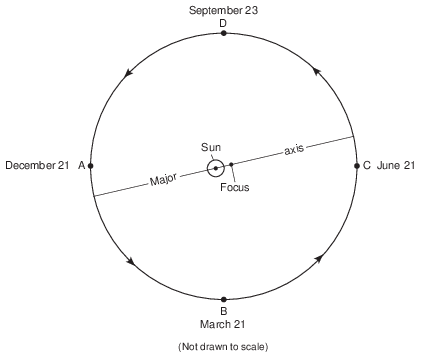
At positions A, B, C, and D, the north end of Earth’s axis of rotation is pointing toward
(1) Betelgeuse
(2) Polaris
(3) the center of the Milky Way
(4) the center of our solar system
The diagram below represents an observer measuring the altitude of Polaris.

At which latitude is this observer located?
(1) 16° N
(2) 37° N
(3) 53° N
(4) 90° N
New York State’s highest peak, Mt. Marcy, is located at approximately
(1) 44°10⬘ N 74°05⬘ W
(2) 44°05⬘ N 73°55⬘ W
(3) 73°55⬘ N 44°10⬘ W
(4) 74°05⬘ N 44°05⬘ W
The model below represents the apparent path of the Sun across the sky on March 21 as seen by an observer on Earth.

At which latitude is the observer located?
(1) 90° N
(2) 42° N
(3) 23.5° N
(4) 0°
On April 21, the altitude of Polaris, as viewed from a location in New York State, was measured as 41.3°. What will the altitude of Polaris be when viewed one month later, on May 21, from the same location?
(1) 23.5°
(2) 41.3°
(3) 66.7°
(4) 90°
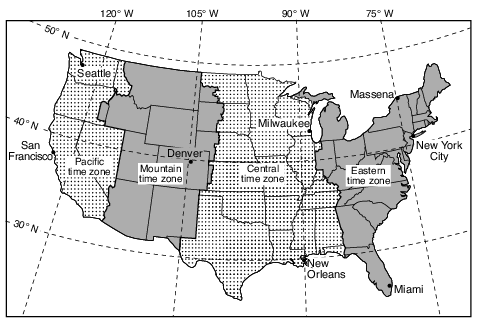
Identify the city on the map where the altitude of Polaris is closest to 45 degrees. [1]
Allow 1 credit for Massena.
A student was interested in how the angle of insolation affects absorption of radiation. The student took three black metal plates, each containing a built-in thermometer, and placed them at the same distance from three identical lamps. The plates were tilted so that the light from the lamps created three different angles of incidence with the center of the plates, as shown in the diagram. The starting temperatures of the plates were recorded. The lamps were turned on for 10 minutes. Then the final temperatures were recorded.

The metal plate at a 90° angle of incidence represents a location on Earth at solar noon on March 21. What is the latitude of this location? [1]
Allow 1 credit for 0° latitude or the equator.
At which latitude is Polaris observed at an altitude of 66.5°? [1]
Allow 1 credit. Acceptable responses include, but are not limited to:
• — 66.5° N or 66 1__2 ° N or 66° 30' N
• — at the Arctic Circle
• Note: Units and a compass direction must be included if a numerical latitude is given.


Identify the latitude and longitude of the eye of Hurricane Wilma on October 24. Label your answer with the correct units and directions. [1]
Latitude:
Longitude:
Allow 1 credit. Acceptable responses include, but are not limited to:
• Latitude:
• — 27° N
• — 27 degrees North
• Longitude:
• — 80° W
• — eighty° west
What latitude on Earth receives the vertical rays from the Sun when Earth is at position M? [1]
Allow 1 credit. Acceptable responses include, but are not limited to:
• — 0°
• — equator
• Note: Allow credit even if the student wrote “0° N” or “0° S.”
Hurricane Sandy
In October 2012, Hurricane Sandy produced extreme damage to New York City and the coast of New Jersey due to high winds and a high storm surge. A storm surge is the rise in the level of ocean water along a coast that is caused by strong winds blowing toward land from a severe storm. High ocean tides, occurring at the same time, added to the height of the storm surge. A high-pressure center, located just south of Newfoundland, Canada, affected Hurricane Sandy by altering the path of the jet stream. This change in the jet stream, combined with surface wind circulation around the high-pressure center, caused Hurricane Sandy to curve westward, making landfall along the coast of New Jersey.
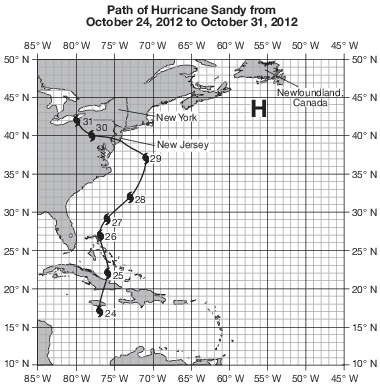
Using information from the map, complete the data table in the image below by identifying the latitude and longitude positions of the eye of Hurricane Sandy from October 27, 2012 to October 29, 2012. Express your latitude and longitude positions to the nearest whole degree. [1]

Allow 1 credit if all three student latitudes and all three student longitudes are correct.
• 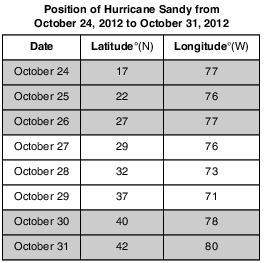

State the altitude of Polaris as seen by an observer on Slide Mountain. [1]
°
Allow 1 credit for 42°.
• Note: Do not allow credit if a compass direction is given (e.g., 42 N or 42° N) because that
• indicates latitude, not altitude.
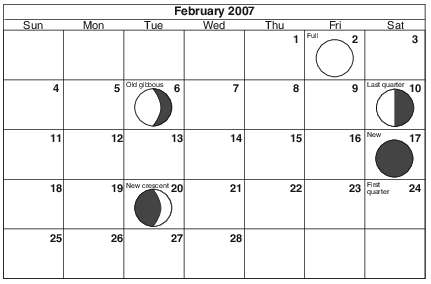
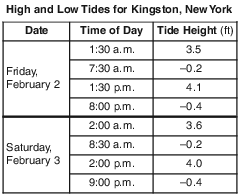
Determine the altitude of Polaris at Kingston, New York, to the nearest degree. [1]
°
Allow 1 credit for 42°.
